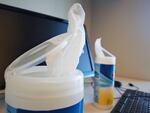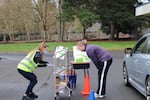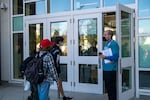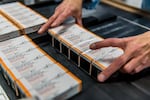COVID-19 cases are surging in Oregon due to the omicron variant. The Oregon Health Authority’s latest update shows an increase in both cases and hospitalizations, with a 22.9% test positivity rate.
The rise of omicron has coincided with the return to school after winter break, and schools across the state and country are dealing with the impacts of COVID-19 related absences.
I know parents, students, and educators are frustrated by temporary school closures due to Omicron. It’s critical when schools make the difficult decision to return to distance learning that they have a timeline in place to return students to the classroom quickly and safely.
— Governor Kate Brown (@OregonGovBrown) January 13, 2022
OPB received questions about the impact of omicron and schools, and asked OHA, the Oregon Department of Education, school districts, and Dr. Dawn Nolt at Oregon Health & Science University for answers.
Some of these answers have been edited for clarity.
Q: Will my school district close?
School leaders at the state and local level have called school closures a “last resort,” but schools continue to close, either on a school-by-school basis or district-wide. You can view a running list of school closures here, but things continue to change daily as schools deal with staffing shortages and increasing student absences.
Neil Armstrong Middle School in Forest Grove had 27% of licensed staff and 27.5% of students absent Wednesday. Nine positions for absent teachers were unfilled. The district announced a transition to remote learning through January 21.
Though many schools have remained open, school districts like Bend-La Pine in central Oregon have shared warnings that families be prepared just in case.
“Our goal is to keep our students learning in-person, every day, as we know that this is the best place for them academically, socially, mentally and emotionally,” said Bend-La Pine superintendent Steven Cook in a recent message to families.
“However, we cannot continue to provide on-site instruction in a safe environment if we do not have sufficient staffing.”

The courtyard at Kellogg Middle School last September. Some schools have covered outdoor seating areas in order to keep students dry while eating outside.
Elizabeth Miller / OPB
Q: How can students eat safely without dry spaces to eat outside?
Some schools, like David Douglas High School, have covered outdoor seating areas in order to keep students dry while eating outside. It’s a move Portland Public Schools and West Linn-Wilsonville have also made, according to the Oregonian and the Wilsonville Spokesman.
Q: Is there any data that show omicron as being more easily transmissible with current safety protocols in schools?
OHSU’s Dr. Dawn Nolt said there is no available data to show that existing protocols — including masking, physical distancing, increased ventilation, and hand washing — are no longer effective against the omicron variant.
“However, it is important to remember that schools are an extension of the community,” Nolt said. “So, if we see a higher rate of transmission in the general community, it is likely that we will see an increase of transmission in our schools as well.”
According to OHA, community transmission is high in every Oregon county.
In responding to this question, officials from OHA and ODE say the “primary reason” for schools moving to temporary distance learning is due to staffing levels. “Even with high community spread,” said ODE and OHA officials in an email to OPB, “consistently implementing these practices keeps COVID-19 from spreading in structured school environments.”

Using sanitizing wipes can help prevent disease spread.
Jes Burns / OPB
“We must set our COVID fatigue aside and reteach, reestablish, and reemphasize all the layered mitigation protocols:
- Get vaccinated and boosted to avoid quarantines
- Wear properly fitting masks to limit spread
- Maintain physical distance
- Provide opportunity for frequent hand washing
- Even through the winter months, maintain good airflow and ventilation”
Q: What criteria are schools using to determine whether or not to move to distance learning?
Most schools are looking at staffing levels, student absences, and the number of students and staff testing positive for COVID-19. In Beaverton, for example, officials shared that the district was “close to a tipping point” in terms of safely operating schools. Since returning from break, the district has faced high numbers of student and staff absences, with an increase in the number of positions unable to be filled by substitute teachers. Thursday, the district announced five schools — four elementary schools and a middle school — were moving to temporary distance learning.

Third grade teacher Jessica Neal helps a parent choose a few books to bring home in March 2020. Along with laptops, the staff at Rock Creek Elementary in Beaverton provided supplies to help their students continue their lessons while staying at home.
Steven Tonthat / OPB
Data from the district shows student absences increased from 5,562 on Jan. 3 to 8,031 on Jan. 10. On Jan. 3, there were 556 staff absences, with 141 unfilled sub positions. On Jan. 7, the district reported 948 staff absences, with 633 absences reported Jan. 10, the following Monday. Unfilled sub positions have grown from 141 on Jan. 3 to 199 on Jan. 10.
Before closing two high schools last week, Portland Public Schools reported increases in student staff absences at both schools. Over the week, the student absence rate at McDaniel High School increased from 25% Monday, January 3, to 29% Thursday, January 6. At Cleveland High School, the student absence rate increased from 19% to 28% over the same four day period. The state’s largest district has since closed eight schools in all — five high schools, two middle schools, and a K-8.
District officials said they’re looking into alleged “coordinated action to be absent,” but did not share more information or details. The union representing Portland teachers has called the accusations “off-base” and “demoralizing.”
District-wide, the student absentee percentage increased from 19% on January 3 to 23% on January 7. January 10, the district reported an absentee percentage of 22%.

Kellogg Middle School principal Richard Smith greets students on the first day of school September 1, 2021.
Elizabeth Miller / OPB
Q: Is this a dangerous situation?
The omicron variant is highly contagious, driving an increase in COVID-19 cases and hospitalizations. At the same time, data show omicron results in less severe illness compared to other variants.
“While a person who gets sick with Omicron may be less likely to be hospitalized than if they were sick with the Delta variant, it will sicken many more people, at a much faster pace, thus increasing the number of people hospitalized,” said state officials.
Nolt said most children who become infected will experience mild or no symptoms of the virus, but there is another risk that comes with infection.
“Parents should also be aware of the potential risks of a condition — called Multi Inflammatory Syndrome in Children (MIS-C) — that may impact children months after a COVID-19 infection. MIS-C can cause severe inflammation in a child’s heart, lungs, brain, kidneys or gastrointestinal organs,” Nolt said in an email to OPB. “While it may be treated, most cases of MIS-C do require hospitalization. The condition can result even if a child did not experience COVID-like symptoms.
Nolt emphasized that the best defense against both conditions is the same.
“A layered approach to protecting yourself, and your children, including vaccination (and boosters), hand washing, distancing and masking, can help to lower the risks of COVID-19 and MIS-C,” she said.
Testing & Quarantine
Q: If my child has COVID, when is it ok to go back? How does that work?
Guidance from the Centers for Disease Control and Prevention says a person who tests positive should isolate at home for five days, no matter their vaccination status. After five days, “if they are asymptomatic or their symptoms are resolving (without fever for 24 hours), follow that by 5 days of wearing a mask when around others to minimize the risk of infecting people they encounter.”
Nolt said parents should consult with their local county health department and school district to determine how to return to the classroom safely.

Over 50 people were waiting in line for a COVID-19 test at the Oregon Convention Center testing site operated by Curative, Jan. 6, 2022. A staff member told people in line that the wait was 45-60 minutes. Getting access to tests has become increasingly challenging.
Kristyna Wentz-Graff / OPB
Q: Are schools going to start using the CDC’s updated quarantine rule, which shortens the quarantine time to five days?
On Monday, the Oregon Department of Education shared the CDC’s updated quarantine and isolation guidance with school leaders across the state.
Multnomah County, Washington County, Clackamas County, Benton County, and Yamhill County have all adopted the CDC’s shortened quarantine.
Lane County offers a quarantine or isolation calculator to determine the length of time a person should stay inside after testing positive for COVID-19 or being exposed to COVID-19.
Individual districts have also indicated that they are adopting the updated quarantine rule, including Portland Public Schools, Newberg, and others.
Masks
Q: Should students be wearing KN95 masks instead of cloth or other masks? What if they’re fully vaccinated?
Masks are recommended regardless of vaccination status. State officials said it’s important to choose a face covering that fits well and is “comfortable enough to wear for the school day,” according to ODE and OHA.
“KN95 masks are effective as is any well-fitting face covering that covers the nose and mouth” with several layers of fabric, according to ODE and OHA.
Q: Will schools make KN95 masks mandatory? Will schools have KN95 or other high filtration masks available for students, or for staff?
There is no current statewide rule making KN95 masks mandatory, but officials at OHA and ODE said they “consult regularly on safety measures.”
Beaverton has updated its recommendations for masks based on the omicron variant, suggesting N95s, KN95s, or KF94 masks, as the “best option” and cloth masks as the worst option.

This September 2021 image provided by Pfizer, Inc., pediatric doses of the Pfizer-BioNTech COVID-19 vaccine are prepared at the company’s Puurs manufacturing plant in Belgium.
Courtesy of Pfizer Inc. / Pfizer Inc.
Vaccines
Q: When will school boards vote on vaccine mandates for students?
At this point, no school board in Oregon has voted on a vaccine mandate for students. Portland Public Schools had considered a mandate, but agreed to delay a possible vote for “at least six months.” Some students supported a mandate.
Nationally, a couple of school districts in California have moved to require the COVID-19 vaccine for students, but Los Angeles Unified, the 2nd largest district in the country, recently delayed the implementation of its student vaccine requirement until this fall.
Q: Especially with the omicron variant, vaccinated people are at risk of contracting or spreading COVID-19. Does this mean PPS or other districts will stop requiring proof of vaccination for any adults who enter schools?
The Oregon Department of Education said it is not aware of OHA’s plans to change OAR 333-019-1030, the vaccination requirement for teachers, school staff, and volunteers.
Not every adult who enters a school is subject to this requirement. The exception includes short-term visitors, anyone making deliveries, or school board members.
Contact tracing
Q: Who does the contact tracing?
It depends on the school district. At PPS, for example, contact tracing is done by school nurses and nurses from the Multnomah Education Service District.
The district has also added staff for contact tracing “in anticipation that we needed to relieve school staff of that burden,” said PPS HR Director Sharon Reese in a media briefing on January 7.
In Multnomah County, both county and school officials say contact tracing in K-12 schools is strained, or under stress.
Q: Why are we still contact tracing?
Multnomah County has stopped contact tracing in individual cases, but efforts continue in schools. That could change in the coming days, district officials said during a board meeting Thursday, January 11.
During that same board meeting, Multnomah County public health officer Dr. Jennifer Vines said the county and public health officials are figuring out the best use of resources, and the best way to minimize the risk of COVID-19.
“I think things are in flux, and the contact tracing function is under stress,” Vines said.
“I think the real prevention benefit is keeping kids and staff home who are sick, home who test positive, the difficulty when the contact tracing piece is stressed is that we’re not keeping peace with the virus, and our teams are unable to get those notifications to people to stay home and to wait out their period.”
